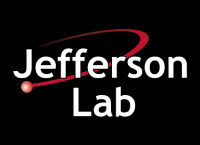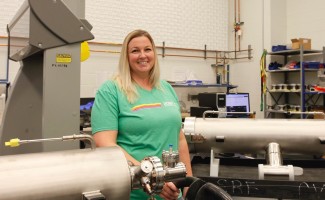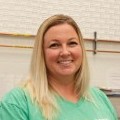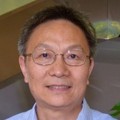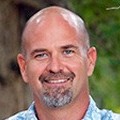Chemist Ensures Optimal Functionality of CEBAF Experiments
Ashley Mitchell considers herself to be a bit of an outlier at Jefferson Lab. In an environment filled with physicists working on cutting-edge experiments, Mitchell is a chemist using tried-and-true formulas to achieve predictable results. Yet, as a superconducting radio frequency chemistry technician II, Mitchell’s role is critical to ensuring that each experiment runs smoothly.
With a job title as long as hers, Mitchell just tells her friends that she is basically a “dishwasher,” she says. “I tell them that I take super-fancy soaps and potent acids and clean things really well so that they have no particles on them—not even a single speck of dust inside of them. My job is to support the physicists and staff scientists at the lab.”
Using Chemistry to Support Physicists
Mitchell receives work orders from scientists and engineers throughout the day as they leave parts and request forms on a receiving table outside of her work room.
She may complete several different types of jobs in a single day. For example, she may prepare metals to be welded by removing impurities from their surfaces; she may use a 1,300 pounds-per-square-inch high pressure rinse machine to remove materials from a cavity for an upcoming experiment with the Continuous Electron Beam Accelerator Facility (CEBAF); or she may run an electrochemical etch on a cavity to smooth the surface for testing.
Measuring Particles Smaller than a Human Hair
Scientists have very clear ideas about what they want Mitchell to achieve in order to ensure their cavity functions optimally for their upcoming experiments. “Scientists will either give us a recipe or tell us what their desired outcome is, so we follow their guidelines,” she explains. “They sometimes say something like, ‘Take off exactly 50 microns’ from a cavity.”
A micron is the equivalent of a micrometer, a millionth of a meter. By comparison, an average human hair is about 100 micrometers thick. “Sometimes they just say, ‘This part needs to be welded and ask us to do a ‘weld prep,’ which means that a surface needs to be cleaned enough so welders can get in and make a quick weld.”
Before Mitchell makes any irreversible chemical adjustments to equipment, she tests her acid solution to determine exactly how many microns will come off once it is applied to the material. She uses both a thickness gauge and a digital micrometer to read results. “We take a sacrificial piece of metal and dip it in the acid to test how much it’s going to etch over a specific amount of time,” she explains. “We may dip the metal for five minutes and then, based on our results, we know how long to dip the actual part.”
Each type of metal requires a different formula. The primary metals used in the lab are niobium, stainless steel, copper and aluminum. “It’s an art form, and I’m learning as I go,” she says. “We have lots of different recipes to work with.”
Safety First
In addition to her everyday role at Jefferson Lab, Mitchell also serves as Chair of the Worker’s Safety Committee. The committee acts as an outlet for the workers of the Lab to voice their concerns about safety to lab leadership. The chemistry room is one of the most dangerous areas of the lab due to the types of acids used, and safety is critical to a healthy work environment. Some of the acids used regularly include hydrofluoric acid, nitric acid, phosphoric acid and acetic acid. When she handles acids, Mitchell wears a full suit of personal protective equipment: rain boots, a rubber smock, a ventilated hood, and three pairs of gloves.
The Art of Science
With a bachelor’s degree in chemistry and a minor in art from Radford University, Mitchell, naturally, views her work in the lab as an art. “All of my professors in college would say that chemistry and art are a great combination. It’s ‘The art of science,’” she says. “With both, you’re manipulating and creating things.”
Though she rarely works with metal in her artistic pursuits these days, Mitchell does maintain an active interest in art, especially when it means she can use art to entertain her friends. “I host paint nights and craft nights for my friends,” she says. “We get together at one of our houses, and I bring the supplies and we paint something together, or we’ll do a craft.”
Mitchell and her husband also enjoy fostering dogs, finding hidden gems at yard sales to restore and resell, drinking craft beer, watching odd movies and gardening. The theme to many of her hobbies—and her role at the lab—is the same: Mitchell brings new life to things that need dusting off and tending.
Chemists at Jefferson Lab use chemicals to:
- Prepare materials to be welded
- Clean items with oxidation
- Polish the interior of cavities
- Process and neutralize acids and acidic water used in the lab
- Remove impurities from the surface of equipment


